Effect of Post Annealing on Antibacterial Activity of Zno thin films Prepared by Modified Silar Technique
R. Sakthivel1, A. Shankar Ganesh1, A. Geetha2, Ba. Anandh 2, R. Kannusamy3 and K. Tamilselvan3
1Department of Electronics, PSG College of Arts and Science, Coimbatore-641014, India.
2,3Department of Chemistry, PSG College of Arts and Science, Coimbatore-641014, India.
Corresponding Author E- mail: rsgvel@gmail.com
DOI : http://dx.doi.org/10.13005/ojc/330142
Zinc oxide (ZnO) thin films were prepared by modified Successive Ionic Layer Adsorption and Reaction (SILAR) method. The optical, structural and antibacterial properties of the prepared ZnO films were analyzed as a function of its annealing temperature lying in the range of 250°C to 450°C. Optical properties were studied using UV-Visible spectroscopy and Photoluminescence spectroscopy (PLS). Optical absorption spectra exhibited blue shift when compared to the bulk value and also the presence of interstitial Zn+ ion defect and oxygen ion vacancy were confirmed in the prepared ZnO thin films by PL studies. X-Ray Diffraction (XRD) pattern revealed the formation of hexagonal phase ZnO and the intensity of the film were found to increase with increase in annealing temperature. Field Emission Scanning Electron Microscope (FESEM) images show the presence of flower like structure and pinhole free film throughout the substrate. Antibacterial activity against Escherichia coli (E.coli) was highly dependent on the presence of interstitial Zn+ ions and for Staphylococcus aureus (S.aureus) it was dependent on oxygen vacancy in the films.
KEYWORDS:ZnO Thin films; PL; XRD; FESEM; Antibacterial activity
Download this article as:| Copy the following to cite this article: Sakthivel R, Ganesh A. S, Geetha A, Anandh B, Kannusamy R, Tamilselvan K. Effect of Post Annealing on Antibacterial Activity of Zno thin films Prepared by Modified Silar Technique. Orient J Chem 2017;33(1). |
| Copy the following to cite this URL: Sakthivel R, Ganesh A. S, Geetha A, Anandh B, Kannusamy R, Tamilselvan K. Effect of Post Annealing on Antibacterial Activity of Zno thin films Prepared by Modified Silar Technique. Orient J Chem 2017;33(1). Available from: http://www.orientjchem.org/?p=30433 |
Introduction
Materials used in hospitals have high risk of bacterial and fungal infections. It is a challenging task to control the bacterial and fungal contamination in hospitals especially in surgical areas and intensive care units1. Various materials are used to control the harmful bacterial contamination, but in some cases it is hard to use those materials because of their harmful effects on human body. So it is important to identify a material that has better antibacterial and antifungal activity, also it should not have negative effect on the human1-3.Comparing to other metals and metal oxide, ZnO is one of the promising materials which has no harmful effects on the human body. It is also widely used in various materials that are in contact with our human body/cells without affecting human body. Many researchers have studied the antibacterial activities 4-7 and antifungal activities 8,9 of ZnO thin films and nanoparticles. Different physical and chemical methods have been employed by researchers to deposit ZnO thin films 4-7, 10. The zone of inhibition observed against pathogenic bacteria and fungal strains suggests that the Co-doped (Ag, Co) ZnO nanoparticles exhibit excellent antibacterial activity than the Ag doped, Co doped and undoped ZnO nanoparticles11. Antibacterial activities against E.coli, S.aureus, Bacillus subtilis, and antifungal activities against Aspergillus niger and Candida albicans have been studied and they have observed better results for ZnO nanoparticles 12. ZnO nanoparticles are used as wood protecting agent against antifungal activities 13 and also it is used in cotton fabrics to protect it from bacterial contamination 14. ZnO nanoparticles are also incorporated in transparent glasses and its antibacterial and antifungal properties were evaluated. These glasses have shown to be functional biocides against E.coli, yeast and S.aureus 15.These glasses can be used in several applications in textiles, protective hospital apparels, surgical instruments, medical implants, water purification systems, food packs, and storage containers. After a wide literature survey, it is understood that ZnO is the prominent material for controlling antibacterial and antifungal activities.
In the present study, ZnO thin films were deposited on glass substrates by modified SILAR method and then were annealed at 250°C, 350°C and 450°C. The Optical, Structural properties and antibacterial activities of the prepared ZnO films have been studied.
Experimental
Cleaning of Glass Substrate
The glass substrate was cleaned with detergent, deionized water and acetone. It is further cleaned with diluted nitric acid and deionized water. Finally it was cleaned with acetone in ultrasonic bathand dried in hot air oven for 10 minutes.
Deposition of Zno thin films
ZnO thin films were deposited on glass substrate by the modified SILAR method. The cationic precursor solution is obtained by dissolving equal molar of zinc acetate dihydrate with monoethanolamine (MEA) in 100ml of ethanol using magnetic stirrer at a room temperature 16 .The anionic precursor solution is obtained by heating deionized water at a temperature near the boiling point17. Glass substrate was alternatively dipped into cationic precursor solution and anionic precursor solution for timings and cycles. The coated glass substrate was dried and annealed at three different temperatures of 250°C, 350°C and 450°C for 1 hour.
Assessment of Antibacterial Activity
ZnO coated thin films were quantitatively assessed for their antibacterial activity against bacteria by percentage reduction method (AATCC 100 -2004). AATCC Bacteriostasis broth and agar medium was used as a growth medium for enumeration. The cultures used in study were collected from Department of Microbiology Laboratory, Kovai Medical Centre and Hospital (KMCH), Coimbatore. The ZnO thin films were taken and were cut into circular swatches of 4.8± 0.1 cm diameters, as per the recommended standard. Three sets of sterile AATCC Bacteriostasis broth were prepared each of 100 ml quantity. The prepared ZnO thin films were placed in sterile petridish and 0.1 ml of the test inoculum was loaded using micro pipette. The treated and untreated films were then transferred to the respectively labeled sterile AATCC Bacteriostasis broth. The flasks were then incubated in shaker at room temperature for 24 hours. After incubation, serial dilutions were made up to 10-7 for all the samples. Exactly 0.1ml sample from each dilution was transferred to the sterile AATCC Bacteriostasis agar plates and spread plated. The inoculated plates were incubated at 37°C for 24 hours. The inoculated plates were examined for the presence of bacterial colonies. The percentage reduction (R) of bacteria by the treatment can be calculated by equation
R =100 (B – A) /B 1
A = the number of bacteria recovered from the inoculated treated ZnO thin films.
B = the number of bacteria recovered from the inoculated untreated films.
Result and Discussion
UV – Visible Spectra Analysis
Fig. 1 shows the UV-Vis absorption spectra of ZnO thin films annealed at different temperatures of 250°C, 350°C and 450°C with a broad absorption in the ultraviolet region from 309-367nm, 309-372 nm and 304-377 nm respectively. Similar reports were observed by Kanade et al., in Cu doped ZnO nanoparticles18 .Absorption peaks are found to be shifted to lower wavelength when compared to its bulk value; this is due to the quantum size effect which may be because of small particle size 19,20. Increase in peak broadening from 367 nm (250°C film) to 377 nm (450°C film) indicates that increasing in annealing temperature increases the crystalline nature of thin film (which is also supported by the X-Ray Diffraction analysis), that leads to increase in considerable number of large size particle in prepared thin films 21. A red shift in absorption band was observed by Wang et al with increasing Co doping in ZnO thin films, while similar results is observed with increase in annealing temperature22.
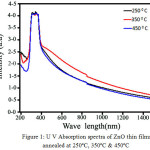 |
Figure 1: U V Absorption spectra of ZnO thin films annealed at 250°C, 350°C and 450°C |
Photoluminescence Spectra Analysis
Fig. 2 shows the PL spectra of ZnO thin films annealed at different temperatures of 250°C, 350°C and 450°C excited using 325 nm. Two emission peaks at Near Band Emission (NBE) and Deep Level Emission (DLE) were absorbed for all three annealed ZnO thin films. Similar kinds of absorption have been reported by Palani et al for Sb doped ZnO nanowire and nanosheet 23. Various researchers have also reported two emission bands at NBE and DLE for ZnO and metal doped ZnO and the results are in good agreement with the reported results 24-27. Both the emissions were slightly blue shifted with increasing the annealing temperature from 250°C to 450°C. Emission band for 250°C annealed sample has low intensity emission at DLE and while increasing annealing temperature from 250°C to 350°C intensity of NBE as well as DLE emission intensity increases. Further increasing the annealing temperature to 450°C leads to decrease in NBE and promotes the DLE emission. Most of the researchers have reported that peaks at NBE are due to the existence of interstitial Zn+ ions and DLE is due to oxygen ion vacancy 23, 27-31. From the results, it is clear that increasing in annealing temperature decreases the existence of interstitial Zn+ ions and increases oxygen ion vacancy and this reduces the intensity of NBE and promotes the intensity of DLE.
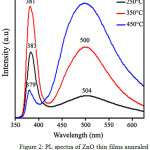 |
Figure 2: PL spectra of ZnO thin films annealed at 250°C, 350°C and 450°C |
XRD Analysis
Fig. 3 shows the XRD pattern of ZnO thin films annealed at different temperatures. Peaks observed at 31.9, 34.64, 36.40, 47.79, 56.89 and 63.16 well match with JCPDS data (card no. 36-1451) and their corresponding (hkl) values are (100), (002), (101), (102), (110) and (103) respectively. From the diffraction pattern, it is observed that the prepared ZnO films exhibit hexagonal phase. The lattice parameters ‘a’ and ‘c’ have been calculated and are 3.23 and 5.18. Crystalline nature of ZnO thin film was found to increase with increasing annealing temperature which is confirmed by the increasing peak intensity and this is in agreement with earlier reports 32, 33. Comparing these results, it is found that increasing in annealing temperature increases the intensity of the peak at two theta value 34.64, and this shows that increase in annealing temperature enhances the (002) orientation in ZnO thin films, similar results has been reported by Shan et al., while increasing the annealing temperature (100°C – 400°C) of ZnO thin films present on Si (100) substrate 34. The crystallite size of prepared ZnO thin films were calculated using Scherrer formula 35
D=0.9λ/ß Cosϴ 2
Where D- crystallite size, λ – wavelength of X- ray source (0.15406 nm), ß-full width at half maximum of the diffraction peak, ϴ – Bragg angle. It was about 19.39 nm, 19.41 nm and 19.08 nm for highest intensity peak value of ZnO thin films annealed at 250°C, 350°C and 450°C respectively.
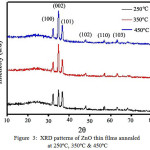 |
Figure 3: XRD patterns of ZnO thin films annealed at 250ºC, 350ºC and 450ºC |
Field Emission Scanning Electron Microscope (FESEM) Analysis
Fig. 4 shows the FESEM image of ZnO thin films annealed at different temperatures. Flower like structure was observed for all the three annealed ZnO thin films and it is found that particles were closely packed with increasing the annealing temperature from 250°C to 450° C. FESEM image clearly shows that deposited ZnO films annealed at 250° C, 350°C and 450° C were homogeneous and pinhole free. Larger particle size was observed from FESEM when compared to XRD, the result is in good agreement with earlier report by Elilarassi et al. They also reported that this larger particle size in SEM image is due to the inter-particle attraction 33.
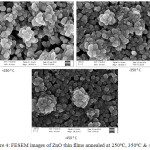 |
Figure 4: FESEM images of ZnO thin films annealed at 250°C, 350°C and 450°C |
Antibacterial Studies
Antibacterial activity was obtained from percentage reduction method for the prepared ZnO thin films and they are shown in fig. 5. Antimicrobial activity of about 86.27%, 93.54% and 85.47 % for gram negative E. coli bacteria and 91.47%, 83.6 % and 84.47 % for gram positive S.aureus bacteria for the film annealed at 250°C, 350°C and 450°C is observed. Antimicrobial activity of ZnO thin film annealed at 350°C was found to be high against E. coli and 250°C annealed film exhibited high antibacterial activity against S. aureus shown in table1. From the previous reports most of the researchers have proposed reasons for the antibacterial activities of ZnO as Zn+ ions release, reactive oxygen species and membrane dysfunction via accumulation of ZnO 35-37. Snega et al., reported that higher antibacterial activity for gram positive bacteria than gram negative bacteria is due to negatively charged radicals that easily attach to gram positive bacteria cell wall and thus kills the bacteria 35. The maximum antibacterial activity of ZnO was against S. aureus. This is because of the firm attachment of ZnO particles to the outer cell wall membrane of the bacteria. After that, ZnO particles begin to release oxygen species into the medium (bacteria), which will inhibit the growth of cell leading to the distortion and leakage of the cell and finally the death of the cell (Ekthammathat et al., 2014) 38. According to the results the higher antibacterial activity of the 350°C and 250°C annealed ZnO films against E.coli and S. aureus is due to Zn+ ions release and reactive oxygen species for gram negative and gram positive organisms respectively. This is observed from the high intensity of NBE and DLE peaks which was due to increase in interstitial Zn+ ions and oxygen ion vacancy respectively. It seems that antibacterial activity against E .coli increases with increasing NBE intensity from 86.27% to 93.54% for 250°C and 350°C annealed ZnO thin films and also it decrease to 85.47% for 450°C annealed ZnO thin film with decreasing its NBE intensity, which confirms that increasing interstitial Zn+ ions increase the antibacterial activities against E. coli. Similarly the antibacterial activity of S. aureus was found to decrease with increase in DLE intensity, which confirms that increasing oxygen ion vacancy decreases the antibacterial activities against S. aureus.
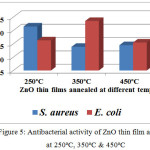 |
Figure 5: Antibacterial activity of ZnO thin film annealed at 250ºC, 350ºC and 450ºC
|
Table 1: Antimicrobial activity against E. coli and S. aureus
|
Test organisms |
Antibacterial Activity (Reduction in Percentage %) |
||
|
ZnO Thin films |
|||
|
250ºC |
350ºC |
450ºC |
|
| E.coli |
86.27 |
93.54 |
85.47 |
| S.aureus |
91.47 |
83.86 |
84.47 |
Conclusion
ZnO thin films have been prepared by modified SILAR technique and annealed for three different temperatures. Optical absorption was found from 304nm to 377nm for all annealed ZnO thin films. NBE in PL spectra confirms the presence of interstitial Zn+ ions and DLE confirms the oxygen ion vacancy. XRD studies reveal that (002) orientation peak intensity was found to increase with increasing in annealing temperature. Antibacterial activity of prepared ZnO thin films on E. coli increases from 250°C to 350°C and decreases from 350°C to 450°C This is due to decrease in the interstitial Zn+ ions with increasing annealing temperature. Antibacterial activity against S. aureus was found to decrease with increase in annealing temperature, which is due to the increases of oxygen vacancy with increasing annealing temperature in ZnO thin films.
Reference
- Quinn J P. Pseudomonas aeruginosa Infections in the Intensive Care Unit, Semin Respir Crit Care Med, 2003, 24, 061–068.
- Wenger PN, Tokars JI, Brennan P, Samel C, Bland L, Miller M, Carson L, Arduino M, Edelstein P, Aguero S, et al. An Outbreak of Enterobacter hormaechei Infection and Colonization in an Intensive Care Nursery, Clin Infect Dis, 1997, 241243–1244.
- T. Elangovan, Rani P. George, P. Kuppusami, D. Mangalaraj, Santanu Bera, E.Mohandas, Dae-Eun Kim, Development of a CrN/Cu nanocomposite coating on titanium-modified stainless steel for antibacterial activity against Pseudomonas aeruginosa, Biofouling, 2012, 28(8), 779-787.
- G. Poongodi, R. Mohan Kumar, R. Jayavel,Enhanced antibacterial activity of transition metal doped ZnO nanorods on thin films, International Journal of ChemTech Research, 6,.3, 2026-2028.
- C. Manoharan, G. Pavithra, M. Bououdina, S. DhanapandianP. Dhamodharan Characterization and study of antibacterial activity of spray pyrolysed ZnO:Al thin films C. Appl Nanosci DO I 10.1007/s13204-015-0493-8.
- Ivanova IA, Tasheva-Terzieva E, Angelov O, Krusteva L, Andonova I, Papazova K, Dimova-Malinovska D and Dushkin C,Effect of ZnO Thin Films on Survival of Pseudomonas Cells, J Nanomed Nanotechol 2012, 3:7
- Deepu Thomas , Jyothi Abraham , Sunil C. Vattappalam, Simon Augustine, Dennis Thomas T,antibacterial activity of pure and cadmium doped zno thin film, Indo American Journal of Pharmaceutical Research, 2014, 1612-1616.
- N. Srinivasan, J. C. Kannan and S. Satheeskumar, Antifungal activity of pure and aluminium doped zinc oxidenanoparticles against aspergillus nigar and aspergillus flavus, International Journal of PharmTech Research, 2014-2015, 7, 2, 287-290.
- Chitra, K. and *Annadurai, G. Antimicrobial activity of wet chemically engineered spherical ZnO nanoparticles on food borne pathogen, International Food Research Journal, 2013, 20(1), 59-64.
- P. S. Shewale , J. H. Kim , A. V. Moholkar , M. D. Uplane Structural and Optical Properties of Undoped ZnO Thin Films Synthesized by Advanced Spray Pyrolysis with Different Thickness, 2014-2015,. 41 (2).
- Sankara Reddy B, Venkatramana Reddy S., Koteeswara Reddy N. and Pramoda Kumari J. Synthesis, Structural, Optical Properties and Antibacterial activity of co doped (Ag, Co) ZnO Nanoparticles), Res. J. Material Sci, February 2013,. 1(1), 11-20.
- Priyanka Singh and Arun Nanda ,Antimicrobial and antifungal potential of zinc oxide nanoparticles in comparison to conventional zinc oxide particles, Journal of Chemical and Pharmaceutical Research, 2013, 5(11),457-463.
- Anitha P, S R Madhan Shankar, Em Rajesh, Namitha Purushothaman,Anulakshmi A and R Rajendran Assessment of the Potential of Zinc Oxide Nanoparticle as a Wood Protective Agent, Bionano Frontier, Jan. to June 2014,.7 (1), 16-22.
- Anita S, Ramachandran T, Koushik C V, Rajendran, Mahalakshmi M, Preparation & characterization of ZnO nanoparticles and a study of the antimicrobial property of cotton fabric treated with the particles, JTATM, 2010, 6, Issue 4.
- Leticia Esteban-Tejeda, Catuxa Prado, Belén Cabal, Jesús Sanz, Ramón Torrecillas and José Serafín MoyaWei-Chun Chin, Antibacterial and Antifungal Activity of ZnO Containing Glasses, PLoS One, 2015, 10(7): e0132709.
- Zhifeng Liu, Zhengguo Jin, Wei Li, Jijun Qiu, Preparation of ZnO porous thin films by sol–gel method using PEG template, Materials Letters, December 2005, 59, 28, 3620–3625
CrossRef - S. Mondal, K. P. Kanta and P. Mitra, Preparation of Al-doped ZnO (AZO) Thin Film by SILAR, Journal of Physical Sciences, 2008, 12, 221-229 221.
- K.G. Kanade , B.B. Kale , Jin-Ook Baeg , Sang Mi Lee , Chul Wee Lee ,Sang-Jin Moona, Hyunju Changa, Self-assembled aligned Cu doped ZnO nanoparticles for photocatalytic hydrogen production under visible light irradiation, Materials Chemistry and Physics, 2007, 102, 98–104.
CrossRef - Soosen Samuel M, Lekshmi Bose and George KC, Optical properties of ZnO nanoparticles, SB Academic Review, 2009, XVI:. 1 & 2, 57-65.
- Shashidhara Bhat, Shrisha B. V, K. Gopalakrishna Naik, Properties of Al doped ZnO thin films grown by spray pyrolysis, Archives of Physics Research, 2013, 4 (4), 20-27.
- Parmod Sagar, P.K. Shishodia, R.M. Mehra, H. Okada, Akihiro Wakahara, Akira Yoshida, Photoluminescence and absorption in sol–gel-derived ZnO films, Journal of Luminescence, 2007, 126, 800–806.
CrossRef - Tao Wanga, Yanmei Liu, Qingqing Fang, Yangguang Xu, Guang Li , Zhaoqi Sun, Mingzai Wu,, Junlei Li , Hao Hea, Morphology and optical properties of Co doped ZnO textured thin films, Journal of Alloys and Compounds, 2011, 509, 9116– 9122.
CrossRef - I.A. Palani D. Nakamura, K. Okazaki, M. Higashihata, T. Okada, Influence of Sb as a catalyst in the growth of ZnO nano wires and nano sheets using Nanoparticle assisted Pulsed Laser Deposition (NAPLD), Materials Science and Engineering, 2011, 176, 1526– 1530.
CrossRef - S. Yılmaz, M. Parlak S¸ Özcan, M. Altunbas, E. McGlynn, E. Bacaksız, Structural, optical and magnetic properties of Cr doped ZnO microrods prepared by spray pyrolysis method, Applied Surface Science, 2011, 257, 9293– 9298.
CrossRef - Aihua Wang, ZhiguoZhong , ChengLu , LinxiaLv , XinchangWang, BinglinZhang, Study on field-emission characteristics of electrodeposited Co-doped ZnO thin films, Physica B, 2011,406, 1049–1052.
CrossRef - Ruey-Chi Wang, Hsin-Ying Lin, Cu doped ZnO nanoparticle sheets, Materials Chemistry and Physics, 2011, 125, 263–266.
CrossRef - Zhao Shirui, Dong Yabin, Yu Mingyan, Guo Xiaolong, Xu Xinwe, Jing Yupeng and Xia Yang, Microwave annealing effects on ZnO films deposited by atomic layer deposition, Journal of Semiconductors ,. 35,. 11.
- A.A.M. Farag, M. Cavas¸ F. Yakuphanoglu, F.M. Amanullah ,Photoluminescence and optical properties of nanostructure Ni doped ZnO thin films prepared by sol–gel spin coating technique, Journal of Alloys and Compounds, 2011, 509, 7900– 7908.
CrossRef - Liqiang Zhang, Zhizhen Ye, Bin Lu , Jianguo Lu, Yinzhu Zhang, Liping Zhu, Jingyun Huang, Weiguang Zhang, Jun Huang, Jun Zhang, Jie Jiang, Kewei Wu, Zhi Xie Ferromagnetism induced by donor-related defects in Co-doped ZnO thin films, Journal of Alloys and Compounds, 2011, 509, 2149–2153.
CrossRef - Zhenhua Yu, Shihui Ge, Yalu Zuo, Guowei Wang, Feng Zhang, Vacancy-induced room-temperature ferromagnetism in ZnO rods synthesized by Ni-doped solution and hydrothermal method, Applied Surface Science, 2010, 256, 5813–5817.
CrossRef - Ramin Yousefi, Burhanuddin Kamaluddin, Effect of S- and Sn-doping to the optical properties of ZnO nanobelts, Applied Surface Science, 2009, 255, 9376–9380.
CrossRef - T.D Malevu, R.O Ocaya, Effect of Annealing Temperature on Structural, Morphology and Optical Properties of ZnO Nano-Needles Prepared by Zinc-Air Cell System Method, Int. J. Electrochem. Sci., 2015, 10, 1752 – 1761.
- R. Elilarassi , G.Chandrasekaran, Microstructural and photoluminescence properties of co-doped ZnO films fabricated using a simple solution growth method, Materials Science in Semiconductor Processing, 2011,14,179–183.
CrossRef - F. K. Shan and G. X. Liu, Annealing Effects of ZnO Thin Films Deposited on Si (100) by Using Pulsed Laser Deposition, Journal of the Korean Physical Society,. 54,. 2, 916-920.
- S. Snega , K. Ravichandran , M. Baneto , S. Vijayakumar, Simultaneous Enhancement of Transparent and Antibacterial Properties of ZnO Films by Suitable F Doping, Journal of Materials Science & Technology, 2015, 31, 759-765.
CrossRef - Rasika Tankhiwale, S.K. Bajpai, Preparation, characterization and antibacterial applications of ZnO-nanoparticles coated polyethylene films for food packaging, Colloids and Surfaces B: Biointerfaces, 2012, 90, 16–20.
CrossRef - J.S. Tawale, K.K. Dey, R. Pasricha, K.N. Sood, A.K. Srivastava, Synthesis and characterization of ZnO tetrapods for optical and antibacterial applications, Thin Solid Films, 2010, 519, 1244–1247.
CrossRef - Ekthammathat N, Thongtem S, Thongtem T, Phuruangrat A, Characterization and antibacterial activity of nanostructured ZnO thin films synthesized through a hydrothermal method, Powder Technology, 2014,.254, 199-205.
CrossRef

This work is licensed under a Creative Commons Attribution 4.0 International License.









